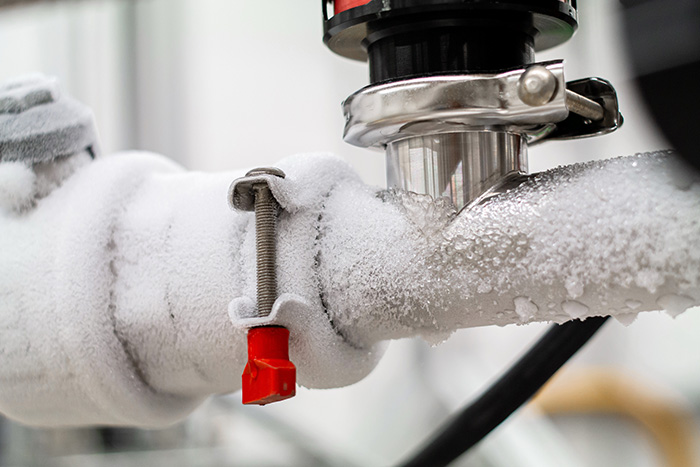Avoiding Frozen Pipes: Effective Strategies for Winter
Avoiding Frozen Pipes: Effective Strategies for Winter
Blog Article
Were you looking for facts and techniques about How to prepare your home plumbing for winter weather?

Winter can damage your pipes, especially by freezing pipelines. Here's just how to prevent it from taking place and what to do if it does.
Introduction
As temperatures decline, the risk of frozen pipelines rises, possibly resulting in costly repairs and water damage. Comprehending how to stop frozen pipes is critical for homeowners in cold climates.
Avoidance Tips
Shielding at risk pipelines
Cover pipelines in insulation sleeves or utilize warmth tape to protect them from freezing temperatures. Concentrate on pipelines in unheated or outside locations of the home.
Home heating techniques
Keep interior rooms adequately warmed, particularly locations with plumbing. Open up cupboard doors to allow warm air to flow around pipes under sinks.
Just how to identify frozen pipelines
Search for lowered water flow from faucets, uncommon odors or sounds from pipes, and noticeable frost on revealed pipes.
Long-Term Solutions
Structural modifications
Consider rerouting pipes away from exterior wall surfaces or unheated areas. Include additional insulation to attic rooms, basements, and crawl spaces.
Upgrading insulation
Buy top notch insulation for pipelines, attics, and wall surfaces. Correct insulation aids maintain consistent temperature levels and decreases the risk of icy pipelines.
Safeguarding Exterior Pipes
Garden hose pipes and outside taps
Separate and drain pipes garden hoses before wintertime. Mount frost-proof spigots or cover outside taps with insulated caps.
Understanding Icy Pipelines
What creates pipelines to ice up?
Pipes freeze when exposed to temperatures below 32 ° F (0 ° C) for expanded durations. As water inside the pipes freezes, it increases, putting pressure on the pipe wall surfaces and potentially causing them to break.
Dangers and damages
Icy pipes can lead to water interruptions, building damage, and expensive repair services. Burst pipelines can flood homes and create substantial structural damages.
Signs of Frozen Water Lines
Identifying icy pipelines early can avoid them from bursting.
What to Do If Your Pipes Freeze
Immediate activities to take
If you suspect frozen pipelines, maintain faucets available to relieve pressure as the ice thaws. Make use of a hairdryer or towels soaked in warm water to thaw pipelines slowly.
Final thought
Protecting against frozen pipes needs aggressive actions and quick reactions. By comprehending the causes, signs, and safety nets, house owners can secure their plumbing during winter.
6 Proven Ways to Prevent Frozen Pipes and Protect Your Home
Disconnect and Drain Garden Hoses
Before winter arrives, start by disconnecting your garden hoses and draining any remaining water. Close the shut-off valves that supply outdoor hose bibs and leave the outdoor faucet open to allow any residual water to drain. For extra protection, consider using faucet covers throughout the colder months. It’s also important to drain water from any sprinkler supply lines following the manufacturer’s directions.
Insulate Exposed Pipes
Insulating your pipes is an effective way to prevent freezing. Pipe insulation is readily available at home improvement stores and is relatively inexpensive. Pay close attention to pipes in unheated areas such as the attic, basement, crawl spaces, or garage. Apply foam insulation generously to create a buffer against the cold. You can also wrap your pipes in heat tape or thermostat-controlled heat cables for added warmth.
Seal Air Leaks
Inspect your home for any cracks or openings that could let in cold air. Seal any holes around the piping in interior or exterior walls, as well as the sill plates where your home rests on its foundation. Additionally, make sure to keep your garage door closed unless you’re entering or exiting. Leaving it open creates a significant air leak that can lead to frozen pipes.
Allow Warm Air Circulation
During cold snaps, it’s essential to allow warm air to circulate evenly throughout your home. Leave interior doors ajar to promote better airflow. Open kitchen and bathroom cabinets to help distribute heat consistently around the rooms. If you have small children or pets, be sure to remove any household chemicals or potentially harmful cleaners from open cabinets for safety.
Let Faucets Drip
A small trickle of water can make a big difference in preventing ice formation inside your pipes. When temperatures drop significantly, start a drip of water from all faucets served by exposed pipes. This continuous flow helps prevent the water from freezing. Additionally, running a few faucets slightly can relieve pressure inside the pipes, reducing the chances of a rupture if the water inside does freeze.
https://choateshvac.com/6-proven-ways-to-prevent-frozen-pipes-and-protect-your-home/

Hopefully you liked our article about How to prepare your home plumbing for winter weather. Thanks a lot for taking a few minutes to read through our short article. Do you know about someone else who is truly interested in the niche? Feel free to share it. We appreciate your readership.
Source Report this page